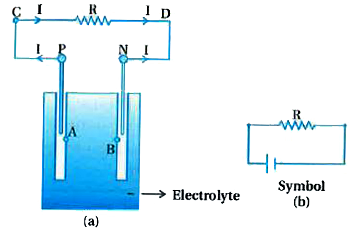Explain cell, emf and internal resistance. Derive relation between potential difference emf and internal resistance. Solution in Gujrati
⇒ As shown in figure in a glass vessel electrolyte is field in.

⇒ In this electrolyte tw" electrode are partially dipped. One electrode is positive electrode (P) and second electrolyte is negative (N) .
⇒ Electrodes dipped in electronde exchange electric charge in form of positive and negative ion produced as result of positive and negative ion produced as a result of chaemical reaction.
⇒ Potential difference between electrode A and electrolyte is (V+V+>0) and potential difference between electrolyte and negative electrode is V−V−<0.
⇒ When current is not flowing in the circuit potential drift between two point P and N.
V+−(V−)
= V++V−
⇒ Potential difference between V+andV− is called electromotive force (emf) of the cell, it is denoted by ε.
ε=V++V−>0 .... (1)
⇒ Definition of emf of cell : " When unit positive charge moves from negative to positive terminal of cell due to non electric force then energy gained by charge is called emf of cell. "
.ε. is not force force but it is potential difference.
⇒ Consider resistor R connected to cell as shown in figure.
⇒ In resistor R, current I flows from C to D.
⇒ In electrolyte steady current flows from negative terminal (N) to positive tenninal (P) and in resistance current Hows from P to N.
⇒ If resistance R is infinite then,
I=VR=Vinfinite=0
where, V is potential difference between P and N.
∴V=[p.d. between p and N [ +
[ p.d. between A and B ] +
[ p.d. between B and N]
= V++(−Ir)+V−
=V++V−−Ir
ε=V++V−
In open circuit condition,
I = 0
∴V=ε
⇒ Thus, ε is potential difference between positive and negative electrode.
⇒ If R be finite resistance of the circuit then potential difference between P and N ,
V = ε−1r ...(2)
⇒ Practically If ε> Ir then internal resistance of cell can be neglected.
⇒ For different cell internal resistance is of different value .
⇒ Internal resistance of dry cell is large compared to internal resistance of electrolytic cell.
⇒ When current I flows through R, then p.d. between two end of resistance,
V = IR ... (3)
from equation (2) and (3)
IR = ε- Ir
or I = εr+R
when R = 0 maximum current tlow through cell.
∴Imax=εR
Remember :
(1) When cell is not in use then,
V = ε
(2) In case of open circuit condition,
V=ε
(3) When cell is in use , (V<ε)
(4) When cell is being charged, (V>ε)
∴V=ε+Ir
Topper's Solved these Questions
- CURRENT ELECTRICITYBOOK - KUMAR PRAKASHANCHAPTER - CURRENT ELECTRICITYEXERCISE - SECTION [A] TRY YOURSELF
74 Videos
- CURRENT ELECTRICITYBOOK - KUMAR PRAKASHANCHAPTER - CURRENT ELECTRICITYEXERCISE - SECTION [B] NUMERICALS (NUMERICAL FROM TEXTUAL ILLUSTRATIONS)
14 Videos
- BOARD'S QUESTION PAPER MARCH-2020 BOOK - KUMAR PRAKASHANCHAPTER - BOARD'S QUESTION PAPER MARCH-2020 EXERCISE - PART-B SECTION -C
4 Videos
- DUAL NATURE OF RADIATION AND MATTERBOOK - KUMAR PRAKASHANCHAPTER - DUAL NATURE OF RADIATION AND MATTEREXERCISE - Section-D (MCQs asked in GUJCET/Board Exam)
1 Videos
Similar Questions
What is reason behind producing electric force between two particles ?
View Solution(a) Esttimate the average drift speed of conduction electrons in a copper wite of cross-secttonal area 1.0×10−7m2 carrying a current of 1.5A. Assume the each copper atom contrbutes roughly one conduction electron. The density of copper is 9.0×103kg/m3, and its atomic mass is 63.5u. (b) Compare the drift speed obyained above with, (1) thermal speeds of copper atoms at ordinary temperaturtes. (ii) speed of propagation of electric field along the conductor which causes the drift motion.
View SolutionDerive an expression for current I passing through an AC circuit containing only inductor L. Draw a Phasor diagram and graph of v and I versus ωt. Explain instantaneous power and the average power.
View SolutionMass of photon in motion is ………
View SolutionA cell of emf epsilon and internal resistance (r) is connected in series with an external resistance (nr) then the ratio of the terminal potential difference to emf is:
View SolutionDerive a relation between internal resisance and emf of a cell.
View SolutionA cell of emf 'E' is connected across a resistance R.The potential difference between the terminals of the cell is found to be "V" .The internal resistance of the cell must be:
View Solutionv31
View SolutionA resistance R is connected across of a cell of emf epsi and internal resistance r and the potential difference between the terminals of cell is found to be V. The internal resistance of the cell is given by the relation r = _____
View SolutionThe emf of a cell having internal resistance is
View SolutionWhat is the potential difference between two terminals of cell of emf of 6V in the open circuit ? Neglect the internal resistance of the cell.
View SolutionWrite down the relation between the emf of cell and its internal resistance.
View SolutionFind relation between emf and internal resistance of a cell.
View SolutionA cell of emf E is connected across a resistance R. The potential difference between the terminals of the cell is found to be V. The internal resistance of the cell must be -
View SolutionWhat are the differences between terminal potential difference and emf of the cell. Deduce an expression for internal resistance of a cell.
View Solution
